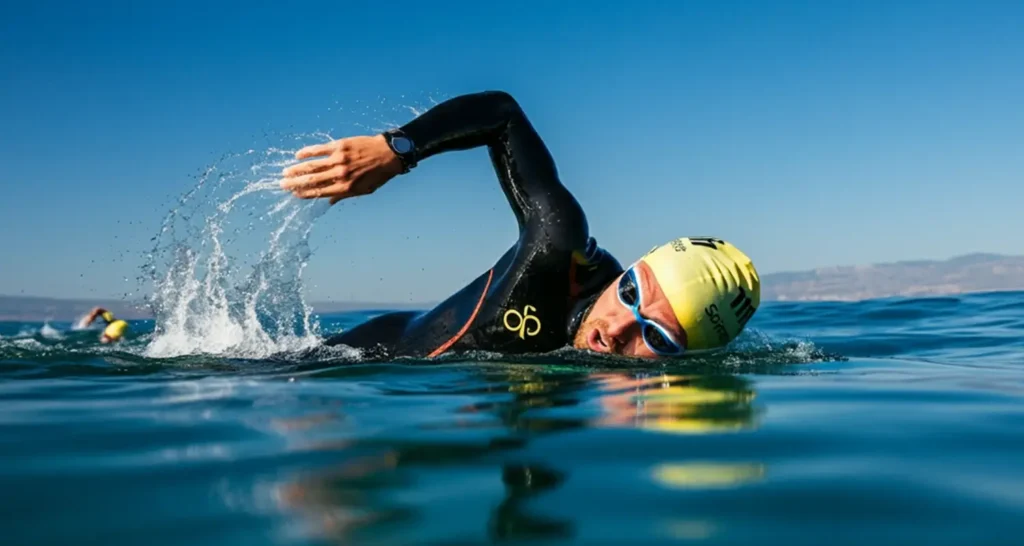
The swim leg of a Half Ironman (70.3) triathlon is often the most anxiety-inducing part of the race for beginners. Questions like “Will I make the cut-off?” or “What happens if I’m too slow?” can overshadow the excitement of the event. This guide demystifies the Half Ironman swim cut-off time, offering actionable strategies to help you conquer the clock and start your race with confidence.
How many Meters Ironman Swim?
| RACE TYPE | SWIM |
|---|---|
| Ironman | 2.4m / 3.8km |
| Half Ironman / 70.3 | 1.2m / 1.9km |
| World Triathlon | 2km |
| Olympic | 1.5km |
What is the Half Ironman Swim Cut Off Time? (The Definitive Answer)
The standard Half Ironman swim cut-off time is 1 hour and 10 minutes (1:10:00) from the start of the last wave of athletes. This applies to the 1.2-mile (1.9 km) open-water swim segment. To meet this deadline, you’ll need to maintain a pace of approximately 3:41 per 100 meters (or 3:20 per 100 yards).
Key Facts:
- Distance: 1.2 miles / 1.9 km
- Cut-off Pace: 3:41/100m (3:20/100yd)
- Timing Basis: Starts when the final wave begins, not your individual start time.
Why Does the Swim Cut Off Exist?
Cut-off times ensure the safety of athletes and the logistical feasibility of the event:
- Safety: Medical and safety staff can’t monitor swimmers indefinitely.
- Logistics: Permits for road closures and volunteer shifts are time-bound.
- Fairness: Ensures all athletes transition to the bike course within a reasonable window.
What Happens If You Miss the Cut Off?
If you exceed 1 hour and 10 minutes, race officials will remove you from the water, and you’ll receive a DNF (Did Not Finish)18. While some independent races may allow unofficial participation, Ironman-branded events enforce this strictly.
Emotional Impact:
- Disappointment is natural, but use it as motivation for future training.
- Reassurance: Many athletes face setbacks—focus on incremental progress.
Is the Cut Off Strict?
Yes. Ironman 70.3 events enforce cut-offs rigorously to comply with permits and safety protocols. Exceptions (e.g., extreme weather) are rare and not guaranteed.
How to Find Your Race’s Cut Off Time
- Check the Official Race Website: Look under “Athlete Guide” or “Race Rules”.
- Pre-Race Emails: Organizers often send detailed timelines.
- Race Briefing: Attend for last-minute updates.
Training Strategies to Beat the Cut Off
1. Build Endurance First
- Swim 1.5–2x the race distance in training (e.g., 2,000–3,000 meters).
- Prioritize steady pacing over speed.
2. Master Open Water Skills
- Practice sighting every 4–6 strokes to stay on course.
- Train in conditions similar to your race (e.g., lakes, oceans).
3. Optimize Technique
- Freestyle Efficiency: Reduce drag by improving body rotation and streamlining.
- Wetsuit Use: Enhances buoyancy and speed—practice in one if allowed.
4. Mental Preparation
- Visualize Success: Imagine calmly navigating the course.
- Panic Drills: Practice recovering from accidental gulps of water or contact with others.
Race Day Execution
1. Start Conservatively
- Avoid sprinting at the beginning—steady effort preserves energy.
2. Draft Strategically
- Follow slightly faster swimmers to save 10–20% energy.
3. Stay Calm
- Breathe Bilaterally: Reduces neck strain and improves rhythm.
Average Swim Times vs. Cut Off: Context Matters
| Category | Average Swim Time | Cut Off Time |
|---|---|---|
| Men (Age 30–34) | 38:092 | 1:10:00 |
| Women (Age 30–34) | 39:472 | 1:10:00 |
| Slowest 25% of Swimmers | ~55–65 minutes13 | 1:10:00 |
This data shows the cut-off is generous for most trained swimmers, even those at the slower end.
Debunking Myths
Myth 1: “The Cut Off is Impossible for Slow Swimmers”
Reality: A 1:10:00 swim requires a moderate pace (3:41/100m). With training, even slower swimmers can achieve this.
Myth 2: “Cut Offs Start at My Individual Wave Time”
Reality: The clock starts for everyone when the last wave begins, giving earlier waves extra time.
FAQ
3:41 per 100 meters (1:10:00 total). Use a pace clock in training to internalize this speed13.
Yes! Breaststroke or backstroke are allowed—just keep moving forward15.
Roll onto your back, regain composure, and signal a kayak for assistance if needed11.
Conclusion
The Half Ironman swim cut-off is a surmountable challenge with focused training and strategic race execution. By prioritizing endurance, open-water practice, and mental resilience, you’ll not only beat the clock but also set a strong foundation for the bike and run. Remember: The cut-off isn’t a barrier—it’s a motivator to unlock your potential.
Ready to conquer your Half Ironman swim? Explore our [Triathlon Coaching Programs] for personalized plans to crush your goals!


Pingback: Master the Domino Swim Stroke - besttriathletes.com
Pingback: Ironman 70.3 : Comment Dompter le Temps Limite en Natation ? - lestriathletes.com
Pingback: Ironman 70.3 Cut Off Times: Everything You Need to Know to Beat the Clock - besttriathletes.com